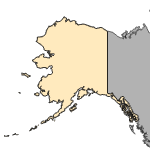Rhodeus sericeus
(Bitterling)
Fishes
Exotic |
|
Common name: Bitterling
Synonyms and Other Names: bitter carp, European bitterling
Taxonomy: available through
www.itis.gov
Identification: Distinguishing characteristics were provided by Berg (1949), Moore (1968), and Page and Burr (1991). Keys were included in Berg (1949) and Moore (1968). Illustrations or photographs appeared in Berg (1949), Maitland (1977), and Axelrod et al. (1985). Another name used for this species is . Berg (1949) apparently recognized two species: R. s. amarus and R. s.Rhodeus amarus sericeus.
Size: 11 cm.
Native Range: Europe from the Seine and other rivers of France eastward to Asia Minor, and northern China (there is a very wide geographical gap in the northern part of the Asian continent separating the ranges of the two subspecies) (Berg 1949; Lee et al. 1980 et seq.).



|

Alaska |

Hawaii |

Puerto Rico &
Virgin Islands |

Guam Saipan |
Hydrologic Unit Codes (HUCs) Explained
Interactive maps: Point Distribution Maps
Nonindigenous Occurrences:
The first records of this species (as Rhodeus amarus) were from the Sawmill River, a tributary of the Hudson River, at Tarrytown, Westchester County, New York in the early 1920s (Dence 1925; Myers 1925; Bade 1926). Although Breder (1933) claimed it disappeared from this locality shortly after 1925, additional specimens were taken in subsequent years (Greeley 1937), with the last collection made in 1951 (Schmidt et al. 1981). Two specimens were taken from the Bronx River at Bronxville, Westchester County, New York, in 1933 (Greeley 1937); subsequent collections indicated the species was established in a localized reach of the river (Lee et al. 1980 et seq.; Schmidt et al. 1981; Schmidt and Samaritan 1984; Smith 1985).
Table 1. States with nonindigenous occurrences, the earliest and latest observations in each state, and the tally and names of HUCs with observations†. Names and dates are hyperlinked to their relevant specimen records. The list of references for all nonindigenous occurrences of Rhodeus sericeus are found here.
Table last updated 4/18/2024
† Populations may not be currently present.
Means of Introduction: Probable aquarium release (Myers 1925; Bade 1926; Lee et al. 1980 et. seq.; Schmidt et al. 1981).
Status: Established in the Bronx River, New York, since at least the early 1930s (Greeley 1937; Schmidt et al. 1981; Smith 1985). Previously established and abundant in Sawmill River, New York; that population is assumed to be extirpated (Schmidt et al. 1981).
Impact of Introduction: The impacts of this species are currently unknown, as no studies have been done to determine how it has affected ecosystems in the invaded range. The absence of data does not equate to lack of effects. It does, however, mean that research is required to evaluate effects before conclusions can be made.
FishBase Summary
Author:
Leo Nico, and Pam Fuller
Revision Date: 4/30/2018
Peer Review Date: 12/5/2003
Citation Information:
Leo Nico, and Pam Fuller, 2024, Rhodeus sericeus (Pallas, 1776): U.S. Geological Survey, Nonindigenous Aquatic Species Database, Gainesville, FL, https://nas.er.usgs.gov/queries/FactSheet.aspx?speciesID=643, Revision Date: 4/30/2018, Peer Review Date: 12/5/2003, Access Date: 4/18/2024
This information is preliminary or provisional and is subject to revision. It is being provided to meet the need for timely best science. The information has not received final approval by the U.S. Geological Survey (USGS) and is provided on the condition that neither the USGS nor the U.S. Government shall be held liable for any damages resulting from the authorized or unauthorized use of the information.